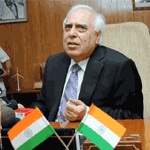Government announces one-man probe into spectrum scam
09 Dec 2010
In a bid to divert from the core issue of corruption in the 2008 allocation of 2G spectrum that caused an over Rs1,76,000 crore loss to the exchequer, the government today appointed a one-man committee of retired Supreme Court justice Shivaraj V Patil to probe possible irregularities in the allocation of radio spectrum since 2001, a period involving the NDA regime as well.
 Announcing this, telecom and IT minister Kapil Sibal said the committee would examine procedures, policies and direction of the department of telecom (DoT) and the government.
Announcing this, telecom and IT minister Kapil Sibal said the committee would examine procedures, policies and direction of the department of telecom (DoT) and the government.
Rather than the projected losses in not auctioning precious radio spectrum, the committee would look into whether the policies and procedures have been consistently followed, Sibal said.
The minister said the retired SC judge would look into various procedures followed in issuing licences during the 2001-09 period.
Separately, the telecom ministry will send notices to the five companies that were given 85 licences despite their being ineligible for telecom licences, asking them why their licences should not be cancelled, he said.
The five companies named in the report of the Comptroller and Auditor General of India (CAG) include Uninor (a unit jointly owned by Unitech and Norway's Telenor), Etisalat DB Telecom (the merged entity of Swan Telecom and Allianz Infratech), Loop Telecom, Videocon Telecommunications and S Tel.
Sibal said his ministry will also send separate notices to 119 telecom licensees that have not complied with service rollout obligations.
"Broadly speaking, we are looking at the internal departmental procedures adopted by the department of telecommunication during the period 2001-09 with the issuance of telecom, access service licences and allocation of spectrum to all telecom access service licensees during the above period," he said.
"There are several terms of references, which will be finalised with the one man committee," Sibal said.
He said the committee will examine procedures, policies and direction of the DoT and the government, and if they were consistently followed or not.
The task of the committee would be to assess the fairness and transparency of the procedure and to see whether they were in keeping with the principles of justice.
.webp)

.webp)


.webp)

























